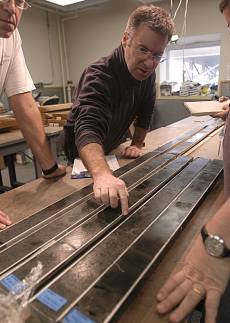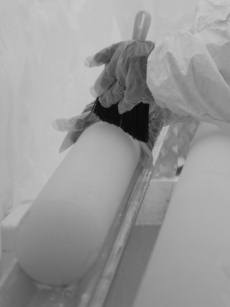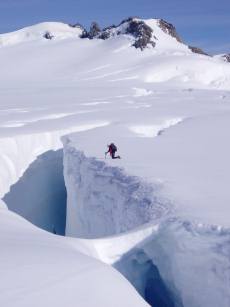Research
Discover the Centre’s key research areas, and how we approach them.

Paleoclimate research
Most of our recent research is in the area of earth science with a particular focus on paleoclimate and history of the Antarctic ice sheet and its role in global sea level changes.
Paleoclimate is the study of climate at some time in the past, and the Antarctic Research Centre’s mission is to improve understanding of Antarctica’s climate history and processes and their influence on the global climate system, especially in New Zealand and the southwest Pacific region.
We believe this field provides exciting opportunities and challenges attractive to young researchers, and is needed to provide a sound basis for international debate and policy development on global climate change issues.
Changes in climate
Earth’s present human-induced global warming trend, its future projection, and changes predicted for the polar regions, oceans, glaciers and our climate have all occurred in the past due to natural causes with devastating consequences for pre-human ecosystems. Our research is motivated by an imperative to understand these past climate processes and especially the role of Antarctic ice sheets in the global climate system during warmer-than-present times, as a basis for more accurate assessment of future climate and sea-level change.
To achieve this we integrate our paleoclimate data with the latest generation of glacier and climate models. Our approach involves the acquisition of data from the climatically-sensitive regions of Antarctica and the Southern Ocean through innovative geological and ice drilling programmes, so that we can understand the link between polar climate drivers and climatic consequences in New Zealand and the SW Pacific.
Current research areas
The current research programme includes:
- climate from sediment cores, for investigating climate from the time of the first ice sheets 34 million years ago
- climate from ice cores, including coastal cores from McMurdo Sound, and permafrost cores from the McMurdo Dry Valleys
- glaciology, glacier and climate modelling of Southern Hemisphere mid-latitude and Antarctic glaciers.
Climate from Antarctic and ocean floor sediment cores

Sediment cores provide the physical evidence of past oscillations in the Antarctic ice sheets that have driven global sea-level fluctuations and the associated changes in ocean currents that move heat between the equator and the poles, over hundreds to millions of years ago.
Our staff and students are participating in large collaborative international drilling projects which have recovered important new sediment cores from Antarctica (ANDRILL programme) and the surrounding oceans (Integrated Ocean Drilling Programme).
Paleoclimate data from these programmes are being integrated with the latest ice sheet and climate models to better predict the future response of Antarctic ice sheets to global warming.
We also have scientific research programmes such as ANZICE, which seeks to understand the likely response of the New Zealand and Antarctic regions to a warmer world.
Antarctic Research Centre staff and students also have a long association with IODP and its predecessors. Staff have been selected to participate during New Zealand’s first year of membership of IODP to recover sediment cores off the Wilkes Land margin of the East Antarctic Ice Sheet.
The Cape Roberts Project was also a major commitment for the Centre for several years.
People involved in this area are:
Climate from Antarctic ice cores

Antarctic ice core research is focused on recovering frozen archives of climate change from coastal glaciers. These regions are highly sensitive to changes in atmospheric circulation (e.g., cyclonic systems) that control Antarctic climate over short timeframes such as several years to decades.
Cyclonic weather systems that circulate around Antarctica have as much influence on our climate as the tropical systems which bring El Nino and La Nina climatic patterns to New Zealand.
The more we can understand about Antarctica’s icy grasp on our climate the better we can plan for the consequences of future climate change in New Zealand.
The ice core research is a collaboration between GNS Science, Victoria University of Wellington and NIWA under the Joint Antarctic Research Institute. It is supported by the New Zealand Ice Core Research Laboratory, a world-class ice core storage and analytical facility at GNS Science, and a ice drilling system developed by the Science Drilling Office.
However with the recognized importance of Antarctica to global climate, the potential of paleoenvironmental information from permafrost and ground ice has also become a hot topic.
Studying the factors that lead to the formation and stability of ground ice, which in the Antarctic may be millions of years old, provides an understanding of the development of many landscape features and is our best analogue for understanding the presence of ground ice on Mars.
People involved in this area are:
- Nancy Bertler - coastal ice cores
- Warren Dickinson - permafrost and ancient ice
Glacier and ice sheet modelling

Our aim is to understand the role of glaciers and ice sheets in the Earth System. In particular, we investigate the interactions between ice and the climate system, both for projecting future changes, and for reconstructing past climates. Our team develops and applies computer models based on physical principles, and collects glaciological data from remote and challenging environments on alpine glaciers and polar ice sheets.
We work on issues that are directly relevant to society, such as predicting the contribution from ice sheets and glaciers to sea-level rise as a consequence of global warming. We also work on improving understanding of more fundamental processes such as firnification, iceberg calving, sliding, and surface energy balance. Our group collaborates closely with ice-core scientists and geologists in the Antarctic Research Centre, as well as the Science Drilling Office. We also work with a number of international glaciology centres, New Zealand universities, and Crown Research Institutes.
People involved in this area are:
Collaborative projects
Staff and students at the Antarctic Research Centre commonly work with people in other institutions. Some of the collaborations are informal, but major collaborations include:
